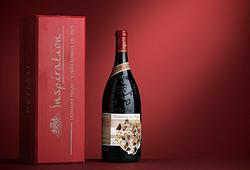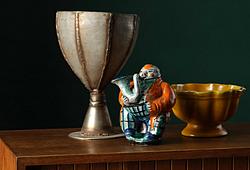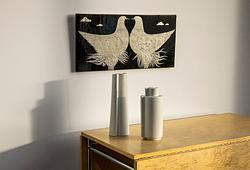A FABERGÉ GOLD, ENAMEL AND SILVER NOBEL JUBELEE LOCKER, workmaster FEDOR AFANASSIEV, St Petersburg, circa 1890
The interior with two glazed miniature oval apertures. the hoop mounted to a brick silver tower, the front with the Imperial eagle, an oil drill tower and two enamel reserves painted with an oli tanker and two oil railway carriers. The back dated 1879-1890 and enamelled text in cyrillic: The Branobel company commemorating 1 000 000 000 pud kerosene (1 pud = 16 kilo). Indistinctly struck with workmaster's initials, 56 gold standard. Height 4,9 cm
damage to ten enameled date 1879
Provenance
Gustaf (Gösta) Nobel (1886-1955)
Thence by decent
Exhibitions
Nationalmuseum, Carl Fabergé, Tsarens guldsmed, Stockholm 6 juni-19 oktober 1997, nr 258
Literature
Dr Geza von Habsburg and Marina Lopato, Fabergé: Imperial Jeweller, The Birbaum Memoirs, s. 454.
More information
One of the keys to success for the petroleum production company Branobel was the company's technichal inventions.
In 1878 Ludvig Nobel produced the first oil tanker 'Zoroaster', built at Motala Mekaniska Verkstad in Sweden.
The very same year they invented the cylinder tank which made a vast different regarding shipping, for instance for shipping by rail.
These two inventions are depicted on the Jubilee locker.
It is well known that the Nobel family appreciated memorabilia to manifest different occasions.
Very famous is the grand Jubilee clock, executed by Fabergé in 1906. That clock was sold at Bukowski's in 2006 for 19,1 milj kronor. The person who made the order for the Jubilee clock to Fabergé was Emanule Nobel ( the half brother to Gösta Nobel). It was most likely Emanuel Nobel who put the order for this locker as well.
Emanuel Nobel was one of the most frequent clients at Fabergé. Franz Birbaum, the head designer at Fabergé, writes "E. Nobel, one of the oil kings, was so very generous with his gifts that it seemed like this was his main task and joy.
There was always work to be executed for E. Nobel going on in the workshops and Emanuel was a frequent visitor to see the progress. Quite often he did not decide who was going to be the receiver until the object was completed in the workshops.


















































